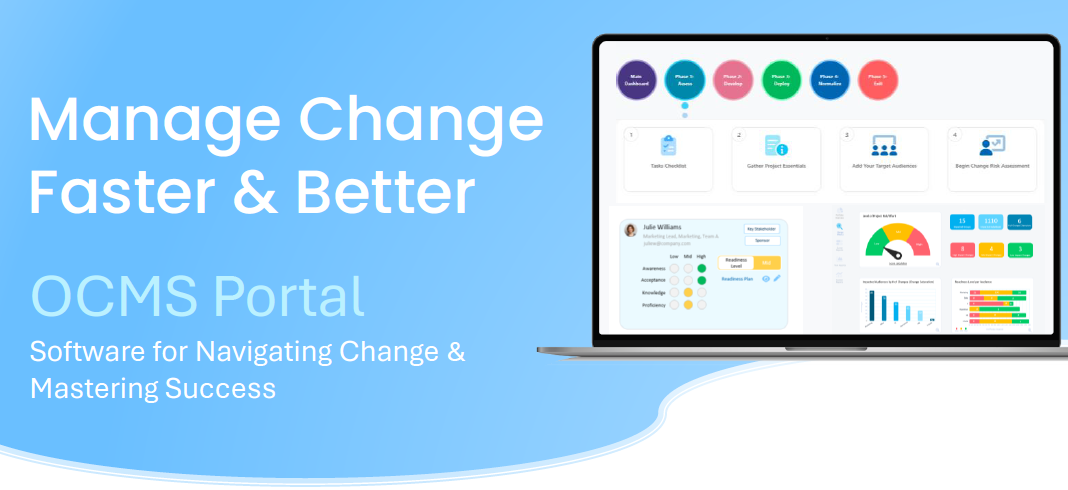Creating a Change-Ready Culture: Tips for Organizational Leaders
Change is part and parcel of our fast-paced, tech-driven world. AI in tools like Microsoft Copilot and ChatGPT have only accelerated the rate of change in organizations of all sizes.
For organizations to ride the waves of change successfully, they need a culture that embraces it at its very core.
A culture of change means employees are adaptable, open to new ideas, and aligned with the organization’s evolving goals. Change management practitioners and leaders are crucial in shaping this change management culture.

So, how do you transition people from being resistant to change to being agile and adaptable? In this article, we’ll explore organizational culture and organizational change. You’ll learn how to build a change-ready culture, the steps for smooth transitions, and Edgar Schein’s organizational culture change model—a vital framework to weave change into the fabric of your organization. Let’s get started!
Key Takeaways
|
Why are Change and Culture Intrinsically Connected?
When leading change in an organization, culture often determines how well the transition is received. Culture is the collective set of beliefs, values, and behaviors shared by people within an organization, influencing how employees react to and embrace change.
A culture of change is one that enables flexibility and encourages a proactive approach toward transformation. Without this, even the best change management strategies can falter. Leadership and culture change go hand in hand. Leaders must recognize that organisational change and culture are inseparable. To succeed in evolving environments, it’s critical to integrate cultural elements into your change management efforts.
Please let us know if you have any questions or feedback about the impact of organisational culture on change management or developing a supportive organizational change culture. We’ll be happy to help.
The Role of Organizational Culture in Change Management
The role of organizational culture in change management cannot be overstated. It dictates how people respond to new processes, technologies, and leadership directives. Organizational culture and organizational change are intertwined because culture shapes how employees perceive change and how they align their behaviors to support it. For leaders, understanding the impact of culture on change management is crucial to navigating both small-scale improvements and large-scale transformations.
Key steps to integrate culture into OCM and create a change management culture strategy include:
- Assessing Current Culture: Understand the organization’s current culture and change management norms and how they may influence change. For example, if a company traditionally resists new technologies, this must be addressed before introducing large-scale digital transformation efforts.
- Leadership Involvement: Leadership must be actively engaged in promoting a culture that embraces change. Employees look to leaders for cues on how to behave during transitions. Leadership and culture change go hand in hand in building a successful organizational change culture.
- Tailoring Communication: Consistent communication that resonates with the existing culture helps align employees with the change agenda. Communication planning and management is a big part of organizational culture change management.
Change and Culture Management: Creating a Change-Ready Culture
To create a culture of change success, organizational leaders must focus on the following areas:
1. Embed Change in Your Corporate DNA
Leaders must cultivate a mindset that change is constant and should be expected. Organizations that treat change as part of their DNA in culture change management are more resilient when transitions occur. This requires clear messaging from top leadership, ongoing training, and creating environments where employees can voice their concerns and share their ideas.
2. Define Clear Roles and Responsibilities
Every change effort should have clear roles and responsibilities. A lack of accountability can lead to change resistance and confusion. Ensure that there is a designated team or individuals responsible for leading the change (this can be a change manager or change management office). By involving employees in the organizational culture and change management process, they are more likely to buy into the transition.
3. Focus on Employee Empowerment and Engagement
A culture of change is built on employee empowerment. When employees feel that they have a say in the corporate culture and change management process, they are more likely to support it. Engagement strategies such as workshops, town hall meetings, and feedback loops ensure that employees are not just passive recipients but active participants in change management and cultural transformation efforts.
4. Provide Continuous Learning Opportunities
Change often brings about the need for new skills. To mitigate fears around change, particularly in the face of new technologies like AI, organizations must prioritize ongoing learning in corporate culture change management planning. Employees who feel equipped to handle change are more likely to embrace it.
If you have any questions about organisational change and culture, the impact of organisational culture on change management, or change management and cultural transformation, please reach out and let us know.
The Edgar Schein Twelve Mechanisms for Culture Change
Edgar Schein, a renowned organizational psychologist and change management pioneer, developed a comprehensive guide to twelve key mechanisms of organisational culture and change management (Edgar H. Schein, Organizational Culture and Leadership (2010). This Edgar Schein change management model is invaluable for leaders looking to transform their company’s culture to support lasting change.
Here’s an overview that provides insight into the importance of culture in change management and how these mechanisms can be applied to building a change management culture:
Primary Embedding Mechanisms
- What leaders pay attention to, measure, and control on a regular basis
- How leaders react to critical incidents and organizational crises
- How leaders allocate resources
- Deliberate role modeling, teaching, and coaching
- How leaders allocate rewards and status
- How leaders recruit, select, promote, and excommunicate
Secondary Articulation and Reinforcement Mechanisms
- Organizational design and structure
- Organizational systems and procedures
- Rites and rituals of the organization
- Design of physical space, facades, and buildings
- Stories about important events and people
- Formal statements of organizational philosophy, creeds, and charters
The Edgar Schein change management model highlights the importance of leadership and strategic alignment of organizational cultural change in change management. By understanding the role of culture in change management, leaders can help foster an environment where change is not only accepted but expected.
Would you like to read more about change and culture management or cultural change management models? Sign up for our monthly newsletter!
Building a Coaching Culture for Change Management
Building a coaching culture is another essential element for supporting change initiatives. A coaching culture ensures that employees at all levels receive guidance, feedback, and support throughout the transition process. This approach not only empowers individuals but also helps embed the behaviors and mindsets necessary for successful change and culture alignment.
Some key steps for building a coaching culture include:
- Developing Internal Coaches: Identify and train employees who can serve as change champions and internal coaches.
- Providing Ongoing Feedback: Encourage open lines of communication where feedback can be given and received freely, helping to adjust behaviors and mindsets.
- Incorporating Coaching into Leadership: Leaders should adopt coaching as part of their management style, continuously supporting employees during change initiatives. This helps strengthen and sustain company culture change management initiatives.
Let us know if you still have questions about organizational culture and organizational change or organizational culture and change management. We’ll be happy to help.
Conclusion: Impact of Culture on Change Management
To navigate change effectively, organizations must recognize the importance of culture in change management. Culture influences every aspect of an organization, from employee engagement to leadership effectiveness.
When planning a transformation, it is crucial to assess change and culture and how each impacts the other, develop a change management culture strategy, and use an organizational culture change model, like Schein’s twelve mechanisms of organisational change and culture to guide the culture change management process.
Building positive organizational culture and change management is not an overnight undertaking. It requires commitment, clear communication, and continuous reinforcement. By focusing on building a coaching culture for change management, aligning leadership with the desired cultural shift, and embedding change into the organizational DNA, companies can create resilient, adaptable environments that thrive in times of transition.
Please reach out if you have any feedback or questions about cultural change in change management, the culture change management process, or the role of culture in organizational change.
Change Management Software for Successful Transformations
Successful organizational culture change management requires a repeatable, effective process for managing stakeholder assessments, surveys, and employee engagement (training, communications, etc.). You need a tool that was designed specifically for this purpose!
That tool is the OCMS Portal. This all-in-one change platform empowers culture and change management teams to collaborate across projects using a repeatable and proven change management process.
Give your organization the toolbox it needs to drive successful change initiatives and stay flexible, adaptable, and competitive.
FAQ: Organizational Culture and Organizational Change
What is the role of culture in organizational change?
When leading change in an organization, culture often determines how well the transition is received. A culture of change is one that enables flexibility and encourages a proactive approach toward transformation. Without this, even the best change management strategies can falter.
What is a good cultural change management model to use?
When managing organisational change and culture, it helps to have a model to guide you. One good organisational culture and change management model is by Edgar Schein. It discusses the driving mechanisms of leadership and culture change and provides insights on how to use those to drive successful corporate culture change management.
What steps can you take to support good organizational culture change management?
To promote healthy organizational culture and organizational change that complement each other, here are some things you should do:
- Embed Change in Your Corporate DNA
- Define Clear Roles and Responsibilities
- Focus on Employee Empowerment and Engagement
- Provide Continuous Learning Opportunities
Note: Content on OCM Solution's ocmsolution.com website is protected by copyright. Should you have any questions or comments regarding this OCM Solutions page, please reach out to Ogbe Airiodion (Change Management Lead) or the OCM Solutions Team today.
External Sources: stock.adobe.com





